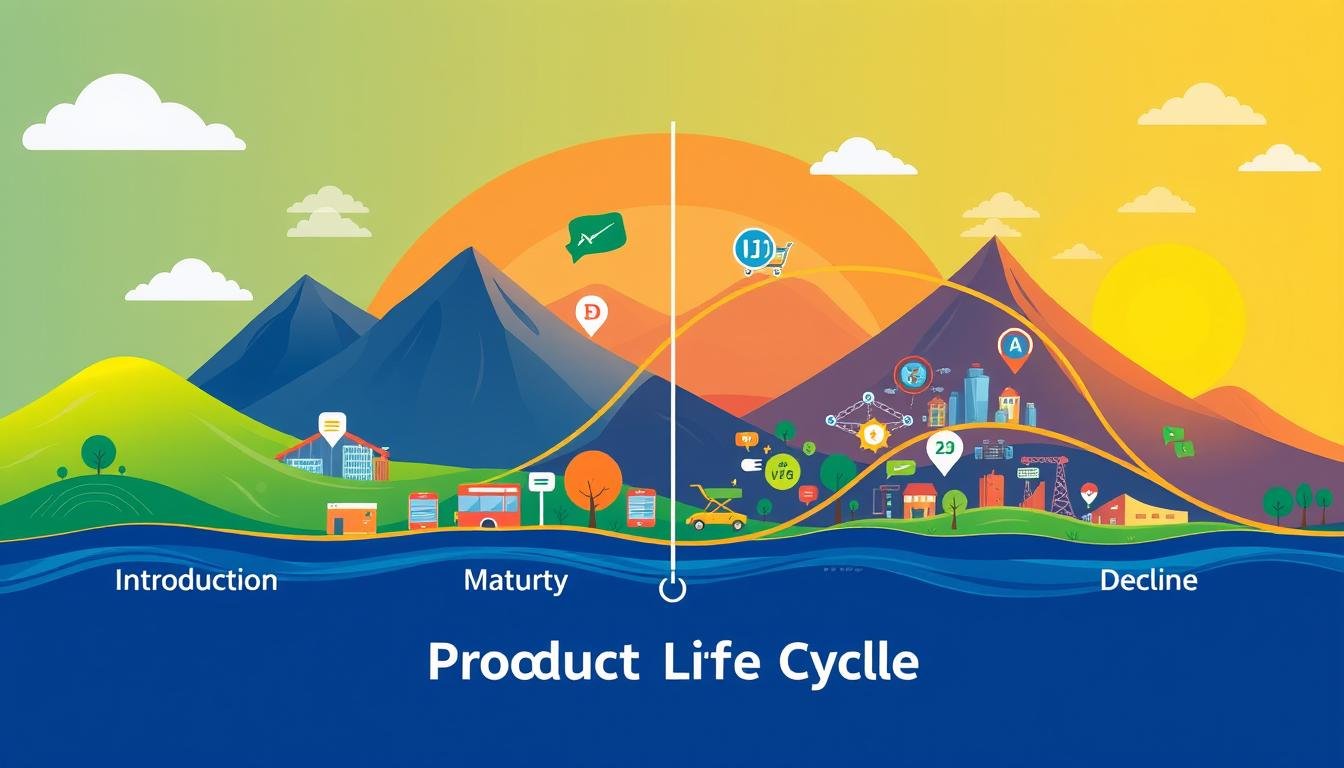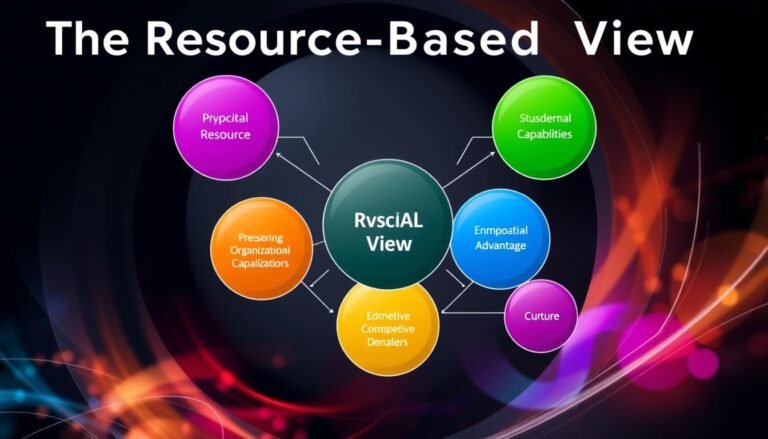Understanding Product Life Cycle Theory
Have you ever thought about why some products stay on top for years while others quickly disappear? The Product Life Cycle Theory explains this. It shows how products go through stages: development, growth, maturity, and decline. This theory, created by Theodore Levitt in 1965, helps managers and marketers make better decisions for over 49 years.
Knowing about these product life cycle stages helps companies meet market needs, make more money, and innovate. It’s useful for understanding why some tech products don’t last long or why brands like Amazon and McDonald’s stick around. Seeing how products change can help with smarter business choices.
Key Takeaways
- The Product Life Cycle Theory outlines the journey of products from development to decline.
- Strategic decisions about pricing and marketing are critical at each life cycle stage.
- Real-life examples reveal the varying lengths of product life cycles across industries.
- Understanding market saturation and competitive edges is crucial during the maturity phase.
- Predicting product longevity can influence investment strategies and future profits.
Introduction to the Product Life Cycle
The Product Life Cycle (PLC) Theory helps us understand how a product moves from its start to its end. It’s key for businesses to know this journey. This knowledge helps them make better marketing plans and keep up with what customers want.
Definition and Significance
A product goes through stages like introduction, growth, maturity, and decline. Each stage has its own challenges. Knowing these stages helps companies make smart choices about ads, prices, and improving their products.
This knowledge lets businesses use their resources better. They can also create marketing plans that really work to boost profits.
Historical Context and Development
The idea of the Product Life Cycle Theory started with looking at product trends and market behavior. Marketing expert Theodore Levitt was a big part of this, showing how important it is to manage new ideas well.
Over time, the PLC has grown to include more stages, like development and standardized products. Companies now use it in their plans to guess sales and adjust their strategies.
Stages of the Product Life Cycle
The Product Life Cycle (PLC) shows how a product moves through different stages. Each stage has its own marketing strategies and challenges. It helps us see how products grow from new to old in the market. The PLC has five main stages: development, introduction, growth, maturity, and decline.
Overview of PLC Stages
Each PLC stage offers both chances and challenges. At the introduction stage, a product is launched with big marketing efforts to get noticed. Then, in the growth stage, more people start buying it, making sales and profits go up.
In the maturity stage, sales stay steady, and companies must keep coming up with new ideas to stand out. The decline stage means fewer people want the product, often because the market is full or tastes change.
Detailed Explanation of Each Stage
Knowing each PLC stage helps businesses plan better:
| PLC Stage | Description | Key Characteristics | Marketing Focus |
|---|---|---|---|
| Introduction Stage | Product launch with high marketing costs | Low sales, high expenses, building awareness | Advertising and promoting product benefits |
| Growth Stage | Rapid increase in product acceptance | Rising sales, entry of competitors, high profits | Increasing market share and brand loyalty |
| Maturity Stage | Sales plateau as market saturation occurs | Sales stabilization, cost reductions, need for differentiation | Promotions, upgrades, and variations |
| Decline Stage | Decrease in sales and product relevance | Falling revenue, need for strategic pivots | Repackaging, pricing strategies, or discontinuation |
Products can stay in each stage for different lengths of time. This shows why market research is key to picking the right strategies. Knowing about the PLC stages helps businesses tackle challenges and seize opportunities as a product moves through its life cycle.
Product Development and Market Introduction
Understanding product development and market introduction is key to success. These steps are more than just launching a product. They involve deep research and development to make sure the product is ready for the market. Doing these right can help a product stand out in the industry.
Importance of Research and Development
Research and development are vital for turning new ideas into market-ready products. By analyzing the market, companies can see what consumers want. This helps shape the product’s design and features. This way, products meet market needs, making them more likely to succeed when they hit the market.
Strategies for Successful Market Introduction
Choosing the right strategies for introducing a product is crucial. Some top strategies include:
- Price Skimming: Starting with a high price to quickly make back costs, then lowering it as competition grows.
- Price Penetration: Setting a low price to draw in customers and quickly increase market share.
- Targeted Advertising: Using marketing campaigns that speak directly to certain groups to reach more people.
- Innovative Packaging: Making the product stand out with unique packaging.
- Market Expansion: Reaching new groups of customers to grow the customer base.
Using these strategies that blend market knowledge with smart action can lead to a successful launch. This helps companies overcome the tough early stages of a product’s life cycle.
| Strategy | Description | Benefit |
|---|---|---|
| Price Skimming | Starting with a high price to quickly make back costs | Recovers costs quickly |
| Price Penetration | Starting with a low price to attract customers fast | Builds rapid market share |
| Targeted Advertising | Marketing aimed at specific consumer groups | Improves customer engagement |
| Innovative Packaging | Unique designs to stand out on shelves | Increases visibility and appeal |
| Market Expansion | Entering new demographic segments | Broadens potential customer base |
Growth Stage in the Product Life Cycle
The growth stage is key in the product life cycle. It’s when products become popular and sales go up. This stage has unique traits that affect marketing and how brands stand out.
Characteristics of the Growth Stage
Products in the growth stage show certain key traits:
- Rapid Sales Increase: As more people learn about the product, sales jump up.
- Heightened Competition: New products come out, making the competition fierce. This pushes companies to innovate and improve.
- Improving Profits: Even with high costs at first, profits get better as the product gains more market share.
- Expanded Distribution: Companies spread out and use more ways to sell their products as demand grows.
- Brand Recognition: Successful products become well-known. It’s crucial to make the brand stand out to keep doing well.
Marketing Strategies for Growth
To do well in this competitive time, companies need strong marketing plans. These plans should use the product’s strengths. Good marketing in the growth stage includes:
- Targeted Advertising: Advertise to specific groups to appeal more and boost sales.
- Strategic Partnerships: Work with big brands or distributors to get noticed more.
- Customer Engagement: Build strong customer ties through loyalty programs and feedback.
- Innovative Promotions: Use special promotions to show off what makes the product unique.
- Market Research: Keep an eye on market trends and what customers want to adjust marketing plans.
Knowing what the growth stage is like helps make good marketing plans. Brands that stand out during this time can really use their market potential. For example, Tesla has grown by offering innovative electric cars that grab people’s attention and interest.
| Characteristic | Impact on Marketing Strategy |
|---|---|
| Rapid Sales Increase | Boost ad spending to grab more market share. |
| Heightened Competition | Make the brand stand out with unique selling points. |
| Improving Profits | Put profits back into making new products. |
| Expanded Distribution | Improve how products get to customers to meet demand. |
| Brand Recognition | Work on making customers loyal to the brand. |
Maturity Stage of a Product
The maturity stage is a key phase in a product’s life cycle. Sales growth slows, and the market gets full. Companies must find ways to stay ahead. Knowing about market saturation is crucial for staying profitable and relevant.
Understanding Market Saturation
In the maturity stage, products reach their highest market share, leading to tough competition. With stable consumer demand, businesses face the challenge of market saturation. This happens when many similar products fill the market, making it hard to attract new customers.
Companies need to study the market and understand what customers want to stay ahead. They must find ways to make their products stand out from others.
Maintaining Competitive Edge During Maturity
At this stage, companies might be cautious and hesitant to try new things. This caution can slow down innovation and focus too much on getting things done quickly. As a result, they might struggle with technology debt, making it hard to adapt to new trends.
To stay competitive, it’s important to invest in new ideas while keeping the core product strong. This balance is key to staying ahead in the market.
Companies that own unique technologies and copyrights can protect themselves from competitors. But, they must find the right balance between new ideas and keeping their current income steady. This approach helps them stay competitive and last longer in the market.
To succeed in the maturity stage, looking at industry examples is crucial. Companies like Facebook, Amazon, and Spotify show how to protect core technologies while innovating. These strategies are key to staying relevant and profitable in a saturated market.
Decline Stage: Challenges and Opportunities
The decline stage is a critical phase in a product’s life cycle. It’s crucial for companies to spot this phase early to keep their market share. Signs of decline include lower demand, fewer sales, and more competition from new products.
Recognizing the Signs of Decline
When a product enters the decline stage, companies must watch for signs of trouble. Key signs are:
- Consistent drops in sales figures.
- Customer feedback showing a move to competitors.
- New innovations from rivals drawing in customers.
Knowing these signs of decline helps companies make smart choices. For instance, Kodak struggled with the rise of digital photography. This led them to change their strategy in the market.
Possible Strategic Decisions in the Decline Stage
In the decline stage, companies have to think about their next steps. They can either leave the market or try to boost sales. Some options are:
- Stopping production.
- Finding buyers for the product or business.
- Improving the product to get customers interested again.
- Using nostalgia marketing to connect with old customers, like Dunkaroos.
Managing well in this phase is key. Brands like Apple have kept their products fresh by updating them regularly. This keeps them relevant in a competitive market.
| Brand | Situation in Decline Stage |
|---|---|
| Kodak | Declined due to the digital photography revolution. |
| Levi’s | Thriving since 1873 and continues to be popular. |
| IBM | Remains a strong tech brand after 100 years. |
| Harry Potter | Valued at over $15 billion, still successful long after initial publication. |
Conclusion
The Product Life Cycle Theory, created by Raymond Vernon, sheds light on how products move from new to old. It helps marketers see key stages like growth, maturity, and decline. This knowledge helps businesses make smart choices about their products and marketing.
Companies need to be flexible as they move through the market. In the growth stage, demand goes up and costs go down, making more profit possible. But in the maturity stage, demand stays the same, and companies must find new ways to stay ahead.
Success in the Product Life Cycle Theory depends on many things, like what customers want and new technology. Companies must act fast, using ads, changing prices, and improving products. By understanding each stage well, businesses can stay competitive and keep their products relevant and successful.
Source Links
- Understanding the Product Lifecycle
- Product Life Cycle Theory – Marketing
- Product Life Cycle Explained: Stage and Examples
- The 6 Stages of the Product Life Cycle [+Examples]
- What Are the 4 Stages of a Product Life Cycle | Mailchimp
- Product life cycle guide: stages and examples
- Product Lifecycle Explained: Stages, Examples, and Product Life Cycle Diagram
- Reading: Stages of the Product Life Cycle
- What is a Product Life Cycle? (Definition, Stages and Examples)
- Reading: Stages of the Product Life Cycle
- Everything About Different Stages of Product Life Cycle and Relevant Examples – Emeritus Online Courses
- What Is the Product Life Cycle?
- How to Manage the Maturity Stage of Product Life Cycle
- Maturity Stage of Product Life Cycle: How to Sustain Growth
- The Decline Stage of the Product Life Cycle: Reasons & Examples | starlight analytics blog
- Decline Stage of Product Life Cycle: Overview and Strategies
- Decline
- Product life-cycle theory
- The Product Life Cycle and How it Affects Your Company







